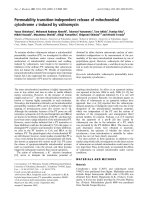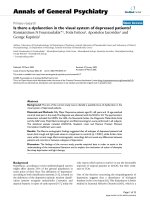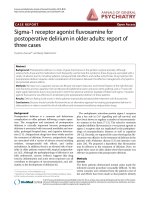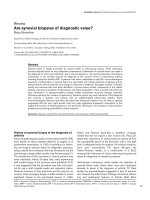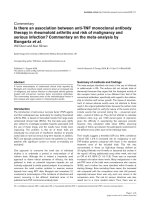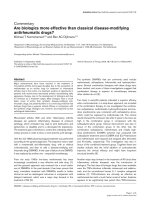Báo cáo y học: "Are there independent predisposing factors for postoperative infections following open heart surgery" ppsx
Bạn đang xem bản rút gọn của tài liệu. Xem và tải ngay bản đầy đủ của tài liệu tại đây (238.69 KB, 24 trang )
Journal of Cardiothoracic
Surgery
This Provisional PDF corresponds to the article as it appeared upon acceptance. Fully formatted
PDF and full text (HTML) versions will be made available soon.
Are there independent predisposing factors for postoperative infections
following open heart surgery?
Journal of Cardiothoracic Surgery 2011, 6:151
doi:10.1186/1749-8090-6-151
Ioanna Lola ()
Stamatina Levidiotou ()
Anastasios Petrou ()
Helen Arnaoutoglou ()
Efstratios Apostolakis ()
George S Papadopoulos ()
ISSN
Article type
1749-8090
Research article
Submission date
23 June 2011
Acceptance date
14 November 2011
Publication date
14 November 2011
Article URL
/>
This peer-reviewed article was published immediately upon acceptance. It can be downloaded,
printed and distributed freely for any purposes (see copyright notice below).
Articles in Journal of Cardiothoracic Surgery are listed in PubMed and archived at PubMed Central.
For information about publishing your research in Journal of Cardiothoracic Surgery or any BioMed
Central journal, go to
/>For information about other BioMed Central publications go to
/>
© 2011 Lola et al. ; licensee BioMed Central Ltd.
This is an open access article distributed under the terms of the Creative Commons Attribution License ( />which permits unrestricted use, distribution, and reproduction in any medium, provided the original work is properly cited.
Are there independent predisposing factors for postoperative infections
following open heart surgery?
Ioanna Lola1, Stamatina Levidiotou1, Anastasios Petrou2, Helen Arnaoutoglou2,
Efstratios Apostolakis3, George S Papadopoulos2.
1Laboratory
2Dpt
of Microbiology, University Hospital of Ioannina, Ioannina, Greece
of Anesthesia and Postoperative Intensive Care, University Hospital of
Ioannina, Ioannina, Greece
3Dpt
of Cardiothoracic Surgery, University Hospital of Ioannina, Ioannina, Greece
Corresponding Author:
Ioanna lola
10 Leonida Str, Eleousa Ioannina 45500, Greece
Phone: 0030-26510-62378, 0030-6974193971
E-mail:
E-mails of authors:
Ioanna Lola ()
Stamatina Levidiotou ()
Anastasios Petrou ()
Helen Arnaoutoglou ()
Efstratios Apostolakis ()
George S Papadopoulos ()
1
Abstract
Background: Nosocomial infections after cardiac surgery represent serious
complications associated with substantial morbidity, mortality and economic
burden. This study was undertaken to evaluate the frequency, characteristics,
and risk factors of microbiologically documented nosocomial infections after
cardiac surgery in a Cardio-Vascular Intensive Care Unit (CVICU).
Methods: All patients who underwent open heart surgery between May 2006
and March 2008 were enrolled in this prospective study. Pre-, intra- and
postoperative variables were collected and examined as possible risk factors for
development of nosocomial infections. The diagnosis of infection was always
microbiologically confirmed.
Results: Infection occurred in 24 of 172 patients (13.95%). Out of 172 patients,
8 patients (4.65%) had superficial wound infection at the sternotomy site, 5
patients (2.9%) had central venous catheter infection, 4 patients (2.32%) had
pneumonia, 9 patients (5.23%) had bacteremia, one patient (0.58%) had
mediastinitis, one (0.58%) had harvest surgical site infection, one (0.58%) had
urinary tract infection, and another one patient (0.58%) had other major
infection. The mortality rate was 25% among the patients with infection and
3.48% among all patients who underwent cardiac surgery compared with 5.4%
of patients who did not develop early postoperative infection after cardiac
surgery. Culture results demonstrated equal frequencies of gram-positive cocci
and gram-negative bacteria. A backward stepwise multivariable logistic
regression model analysis identified diabetes mellitus (OR 5.92, CI 1.56 to 22.42,
p=0.009), duration of mechanical ventilation (OR 1.30, CI 1.005 to 1.69,
p=0.046), development of severe complications in the CICU (OR 18.66, CI 3.36 to
103.61, p=0.001) and re-admission to the CVICU (OR 8.59, CI 2.02 to 36.45,
p=0.004) as independent risk factors associated with development of nosocomial
infection after cardiac surgery.
Conclusions: We concluded that diabetes mellitus, the duration of mechanical
ventilation, the presence of complications irrelevant to the infection during
2
CVICU stay and CVICU re-admission are independent risk factors for the
development of postoperative infection in cardiac surgery patients.
Key-words: cardiopulmonary bypass, cardiac operations, open heart surgery,
coronary artery bypass grafting, post-cardiac surgery infections, ICU infections,
ICU-flora, MRSA
3
Introduction
Postoperative nosocomial infections are a considerable problem in cardiac
surgery patients associated with prolonged hospitalization [1, 2], increased short
and long-term mortality [2, 3] and augmented total treatment cost [4]. The
proportion of coronary artery bypass patients at high-risk for infection is
increasing because of the aging population, a growing number of patients
undergoing “redo” procedures, and the frequency of conditions conferring both
cardiovascular and infectious risks (obesity, diabetes mellitus) among this
population [1].
The diagnosis of postoperative infection is sometimes difficult, since clinical and
laboratory signs of inflammation may be caused not only by infection, but also by
tissue injury and mainly by the systemic inflammatory response syndrome
(SIRS) associated with cardiopulmonary bypass [5]. In addition, surgical patients
usually receive systemic antibiotics, especially in the ICU, thus negatively
influencing blood culture yield [5, 6].
The aim of this study was to examine the incidence of early postoperative
infections in patients undergoing on pump coronary artery bypass grafting
(CABG) surgery, to analyze the kind of infection and the responsible pathogens
as well as to identify the contributing risk factors for these infections.
Material and Methods
This prospective study was conducted between May 2006 and March 2008 at the
Cardio-Vascular Intensive Care Unit (CVICU) of University Hospital of Ioannina.
Following ethical committee approval, all patients included consented to the
terms of this study during the preoperative evaluation and discussion with the
attending anesthesiologist.
The study included patients with coronary artery disease who underwent onpump coronary artery bypass grafting (CABG).
Exclusion criteria were:
-
Any sign of clinical infection preoperatively (fever of ≥38°C or elevated
white blood cell count or elevated CRP).
4
-
Preoperative mechanical ventilation for any reason.
-
Preoperative hospital length of stay >3days.
-
History of: Ca, recent infection or fever of unknown origin, chronic benign
disease, such as rheumatoid arthritis, systemic lupus erythematosus, and
chronic administration of corticosteroids.
-
Intraoperative exclusion criteria:
accidental potential infection (e.g.
accidental abolition of the sterile conditions of the surgical field),
evidence of line’s infection (tenderness, erythema or induration of the
catheter exit site).
-
Postoperative exclusion criteria: low cardiac output postoperatively
observed by using continuous cardiac output monitoring. These patients
were excluded, as they present a higher risk of acquiring an infection due
to the fact that excessive manipulations are needed (infusion of fluids,
inotropic support, intra-aortic balloon pump) and that host defenses may
be impaired.
Patients’ data that were routinely recorded preoperatively were as follows: age,
height, weight, body mass index, body surface area, co-morbidities (see Table1),
hematological and biochemical laboratory results. Coronary angiography data,
the presence of indwelling urinary catheter before the operation and the time of
insertion, the presence of vascular catheters and the time of insertion and the
presence of intra-aortic balloon counter-pulsation device (Intra-aortic balloon
pump - IABP) were also recorded. Taking into account their underlying diseases,
active conditions and co-morbidities, the Euroscore index was calculated
accordingly. According to their Euroscore index, patients were divided in 4
groups: Group I: Euroscore index 1-2, Group II: Euroscore index 3-5, Group III:
Euroscore index 6-12, Group IV: Euroscore index >12.
Intraoperative and postoperative data were recorded to determine their
influence on the development of infection (see Table 2).
Antibiotic prophylaxis with cefotaxime was administered routinely to all patients
intravenously as a single dose (1g) at the induction of anesthesia and
5
postoperatively 1g every 8 hrs for 3 days. In case of suspected infection,
empirical antibiotic therapy was initiated. Treatment was modified according to
culture results.
Diabetic patients received perioperatively continuous insulin infusion to
maintain blood glucose levels between 110 and 150 mg/dL.
All patients included in the study were daily examined, during the morning and
afternoon rounds, by the CVICU attending anesthesiologists for possible signs of
infection. Hematological and biochemical tests, and chest x-ray were performed
every day and vital data were recorded routinely every hour. Sternotomy site
and indwelling catheters’ insertion sites were examined, cleaned and properly
dressed. Bronchial secretions were collected from all patients for culture before
removing the endotracheal tube. Blood cultures from two peripheral sites,
samples for cultures from urine and the tips of removed catheters were taken
from all patients routinely. When wound infection was suspected, cultures were
taken from the inner surface of the wound. In case of suspected infection,
additional cultures of blood, urine, bronchial secretions or bronchoscopy brush
samples and tips of removed arterial or venous catheters were ordered. The
definitions of nosocomial infections were based on those proposed by the
Centers for Disease Control and Prevention (CDC) [7].
Statistical analysis was performed using SPSS v 15.0. Results are presented as
Mean values + Standard Deviation (SD). Statistically significant factors were
initially identified at p<0.20. These were used in a logistic regression model.
Significance was then set at p<0.10 and the factors were reduced with the
Backward LR method. Final pruning of the model was carried out with forward
LR logistic regression at p<0.05 and interactions between statistically significant
factors were also considered.
Results
The study included 172 patients (77.3% males) of mean (±SD) age 66±10 years
old (range 36-85 years). Euroscore Group I (index 1-2) included 31 patients
6
(18%), Group II (index 3-5) included 74 (43%), Group III (index 6-12) included
41 patients (24%) and Group IV (index > 12) included 26 (15%). Groups III and
IV included 67 patients in total (39%) with a combined, estimated risk of death
at 13% (12.61±7.56%). Patients’ characteristics are presented in Table 1.
Intraoperative and postoperative data as well as perioperative transfusions are
shown in Table 2.
The duration of mechanical ventilation in the high risk groups III and IV (67
patients) was 2.79±6.44 days and the length of stay in the CVICU was 5.85±8.92
days. Eleven patients (16.4%) classified in the high risk group were readmitted
to the CVICU, while five of them were readmitted twice. The reasons for
readmission were respiratory (respiratory insufficiency due to pneumonia 3 pts,
pleural effusion 2 pts, marked atelektasis 2 pts), cardiac (cardiac arrest 2 pts,
intractable arrhythmia 1 pts), cerebrovascular accident (3 pts) and re-operation
for a sternal wound debridement (3 pts).
Twenty four patients presented microbiologically documented nosocomial
infection (n=24, 13.95%). Six of these patients presented multiple infections. The
sites of infections are presented in Table 3. Thirteen patients with infection died.
In 6 of them, infection was considered the main cause of death while in the
remaining 7 patients, infection contributed to death as a secondary cause on top
of other complications, irrelevant to infection. Four out of those six patients were
classified to the high risk groups of III and IV of the Euroscore scale. Therefore
total mortality attributed to infection was 3.48% (6/172 pts) and mortality
among infected patients was 25% (6/24 pts).
Causative microorganisms that were isolated and their resistance phenotype are
presented in Table 4, while Table 5 presents the pathogens and their respective
resistance phenotype per infection site. Gram-positive and gram-negative
microorganisms were isolated in equal number of cases. Gram-positive cocci
were the most frequent bacterial species isolated in patients with infection at the
sternotomy and venous graft harvesting sites and in patients with mediastinitis,
whereas gram-negative bacteria were the responsible pathogens in those with
pneumonia and urinary tract infections and also the most common pathogens in
7
patients with bacteremia. Staphylococci were isolated in 40% of cases (12 of the
30), 83.3% of which were coagulase-negative and 58.3% were resistant to
methicillin. Acinetobacter baumannii was the predominant pathogen among
gram-negative bacteria (26.7%), while 60% of enteric gram-negative bacilli were
confirmed to produce ESBL (extended-spectrum β-lactamase).
The
association
of
the
examined
co-morbidities,
intraoperative
and
postoperative factors and perioperative transfusions with development of
microbiologically documented infection after cardiac surgery is presented in
Table 6.
Multivariate analysis using a stepwise logistic regression analysis demonstrated
that diabetes mellitus, the duration of mechanical ventilation, the presence of
complications irrelevant to the infection during CVICU stay and CVICU readmission are statistically significant factors for the development of a
postoperative infection in cardiac surgical patients (Table 7).
Based on the regression analysis, the risk of acquiring an infection is 5.9 times
greater in patients with diabetes mellitus compared to those without diabetes
mellitus. Accordingly, for every day on mechanical ventilation the risk is
increased by 30%, re-admission to the CVICU increases the risk by a factor of 8.6
and patients who presented other complications irrelevant to infection (cardiac,
respiratory, renal, neurological, gastrointestinal, bleeding) in the CVICU had a
18.7 times higher risk of developing infection.
Discussion
In this study, we found that the postoperative infection rate in patients
undergoing on pump CABG surgery during their stay in our small volume,
Cardio-Vascular Intensive Care Unit is 13.95%. This accounts for 24 patients out
of 172 patients treated in this CVICU during the above mentioned time period.
Six of these patients eventually died and infection was considered to be the
primary cause of death. The observed mortality rate attributed to infection was
3.48% and the mortality rate among infected patients was 25%.
8
According to the logistic Euroscore scale, four out of the six patients who died
(4/6=66%), were predicted to have a significantly increased risk of
perioperative death (>6%). As we presented above, 39% of our patients were
classified at Euroscore group III and IV and their combined, predicted mortality
was 13%. All these patients required prolonged mechanical ventilation and
increased length of stay in the CVICU, compared with the remaining patients of
the study. The percentage of these patients in the study (39%) seems to be
greater than in other studies and we attribute this to the special characteristics
of our health region (isolated agricultural population with relatively restricted
access to primary and advanced care facilities), their relatively increased age and
the high percentage of co-morbidities.
Great variation exists in the literature about the rate of hospital infections among
cardiac surgery patients. The ESGNI-008 (European Study Group on Hospital
Infections) study [8] that took place in 42 hospitals in 13 European countries,
found the overall prevalence of nosocomial infections in postoperative cardiac
patients on the study day to be 26.8%. The Fowler et al. study [1] found that
major infection occurred in 3.51% of patients and the associated mortality rate
was 17.3%.
Sternotomy site infection was the most common infection in our study (8
patients, incidence 4.65%, 26.7% of all infections). Most of these patients were
suffering from diabetes mellitus (75%) and two of them eventually died. The
isolated microorganisms were Staphylococcus epidermidis (in 62.5% of cases),
Enterococcus faecium, Acinetobacter baumannii and Pseudomonas aeruginosa.
These rates are quite similar to those reported in the literature (infection rate:
0.4-9.7%, associated mortality rate: 7.2-14.2%, 90% of the cases due to
Staphylococcus species) [9-11].
Central venous catheter-related infections were observed in our study too
(incidence 2.9%, 16.7% of all infections). These findings were again in
accordance with those reported in the literature. Although 4 of the patients who
developed catheter-related infection died, the infection was not considered as
the main cause of death as these patients presented other serious complications
9
during their hospital stay. Michalopoulos et al. [5] described a rate of central
venous catheter-related infection of 1.1% in the total number of patients (25.2%
of those with infection), mainly due to gram-positive cocci.
Pneumonia was diagnosed and confirmed in 4 patients (incidence 2.32%, 16.7%
of all infections) and 3 of them (75%) eventually died. The isolated
microorganisms were Acinetobacter baumannii and Pseudomonas aeruginosa.
These findings were significantly different from those observed by other studies
where pneumonia was the main cause of postoperative infection in cardiac
surgical patients and lower respiratory tract infections represented 57% of all
infections [8]. However, the incidence of pneumonia in our study was in
accordance with others where the incidence varies between 1.2% and 2.1% [1214]. Hortal et al. [15] reported a high mortality rate (45.7%) and the most
commonly isolated pathogens were gram-negative bacteria. We believe we
cannot compare our results with other studies, as the total study population and
the number of patients with infection were really small.
Mediastinitis was diagnosed in only one of our patients (incidence 0.58%, 3.3%
of all infections) and the isolated microorganism was Staphylococcus aureus
resistant to methicillin (MRSA). This patient died due to this infection. According
to the literature data, the incidence of mediastinitis in cardiac surgery patients
ranges from 0.6% to 2.65% [16-18] and the associated mortality varies between
14% and 23% [19, 20].
The incidence of bacteremia in our study was 5.23%. The cases of bacteremia
represented 30% of all infections (9/30). Four of these patients had pneumonia,
one had a vascular catheter infection, one had an IABP infection and three of
them had no other clinical site of infection. The isolated microorganisms in
patients with bacteremia were gram-positive cocci and gram-negative bacteria
(Staphylococcus
epidermidis,
Staphylococcus
haemolyticus,
Acinetobacter
baumannii, Escherichia coli, Enterobacter cloacae, Enterococcus faecium). In a
recent study [21], bacteremia was the second most common cause of clinical
(after pneumonia). The cases of bacteremia represented 26.9% of all infections
10
and 57.1% of them were not associated with any other identifiable infected site
[21].
Finally, less common infections in our study were urinary tract infection (1
patient) and wound infection at the site of venous graft harvesting (1 patient).
Referring to co-morbidities, obesity [18, 19], smoking [11, 19], chronic
obstructive pulmonary disease [18], arterial hypertension [21], and previous
vascular surgery [21] have been previously reported as independent risk factors
for the development of nosocomial infection. However, in our study, only
diabetes mellitus is confirmed as an important risk factor of postoperative
infection in cardiac surgery patients. Another study [22] found that the risk of
infection and other serious life-threatening complications is 36% to 38% higher
in diabetics and that insulin-treated diabetics had the highest risk of serious
complications. In addition, it was observed that infection was a more common
cause of death only in insulin-treated diabetics compared with patients without
diabetes mellitus [22]. Furnary et al. [23] showed that increasing blood glucose
levels were directly associated with increasing rates of death, deep sternal
wound infections, length of hospital stay and hospital cost. They demonstrated
that continuous insulin infusion therapy, designed to achieve predetermined
target blood glucose levels, independently reduced the risks of death and deep
sternal wound infections by 57% and 66%, respectively.
In the assessment of independent risk factors in our study, mechanical
ventilation was proved to be an important factor that predisposes patients to
infection. Our data show that for every day on mechanical ventilation, the risk is
increased by 30%. This risk factor was also reported by other authors [24, 25].
Patients treated on mechanical ventilation for more than 48 hours have a 5.4
times higher risk for developing severe postoperative infection, a 4 times higher
risk for pneumonia and a 4.1 times increased risk for postoperative sepsis of
unknown origin [26]. Mechanical ventilation promotes the introduction of
colonized oropharyngeal contents into the lower respiratory tract mainly due to
aspiration. Subsequent colonization of the lower airway is facilitated by debility,
reduced consciousness, swallowing difficulty and defective host defense [27].
11
Re-admission to the CVICU is also a significant factor for infection. It is often
difficult to discern whether complications that require re-admission are the
consequence of an ongoing infection or they are irrelevant to the infection that
develops after re-admission. Our patients presented 8.6 times higher risk for
infection when re-admitted. The reasons for re-admission were respiratory
(38.5%), cardiac (23.1%), cerebrovascular accident (15.4%), re-operation for a
sternal wound debridement (15.4%), renal insufficiency requiring hemodialysis
(3.8%) and seizure (3.8%). This is in accordance to other studies that also found
that the most common reason for re-admission was respiratory failure,
accounting for 47% of the patients [28]. In a recent study [29], preoperative
renal failure, mechanical ventilation >24 hours, re-exploration for bleeding and
low cardiac output state were independent predictors for re-admission to an
intensive care unit. Chung et al. [30] observed that pneumonia was one of the
most common complications developed during the second admission to the ICU.
They concluded that ICU re-admission and its resultant extended ICU stay is a
major morbidity outcome associated with high mortality and often prolonged
ventilation, in addition to high economic cost [30].
An important finding in our study is that the development of postoperative noninfectious complications is associated with an increased risk of infection. Our
study showed that patients who developed complications had 18.7 times higher
chance of infection than those without complications. According to another study
[31], the development of postoperative complications has been associated with
an increased risk of death and prolonged hospital stay. It is quite interesting that
this study showed that even though cardiac complications are more common,
they are associated with less mortality and shorter ICU and hospital length of
stay than non cardiac complications [31].
The relationship between the administration of blood derivatives and
postoperative infections has been documented in patients undergoing cardiac
surgery [26]. Although perioperative transfusions of RBC concentrates and other
blood components commonly used in cardiac surgery patients, such as plasma
and/or platelets, were implicated in our study in the development of
12
postoperative infection in the univariate analysis (Table 6), it was not confirmed
as an independent risk factor in the multivariate analysis (Table 7).
Furthermore, we did not find a significant relationship between age, ejection
fraction or mode of surgery (elective or emergency) and postoperative infection
in this study.
The main limitation of our study is the small number of the included patients.
This is due to the low volume of patients treated at the Cardiothoracic surgery
Department of our hospital. Additionally, the length of stay at the CVICU could
not be evaluated as a risk factor for infection because of the small number of
included patients and the scarce number of patients that stayed at the CVICU for
>2 days. As a result, it was not possible to divide the patients into sub-groups
according to the length of stay and examine whether the increased length of stay
is associated with a higher rate of infection.
Conclusions
Postoperative infections in cardiac surgery patients represent a serious problem
and are directly related to patients’ co-morbidities, intraoperative factors, as
well as postoperative management. The risk of acquiring an infection is 5.9 times
higher in patients with diabetes mellitus, is increased by 30% for every day on
mechanical ventilation, is 8.6 times higher in patients re-admitted to the CVICU
and is 18.7 times higher in patients who presented other complications,
irrelevant to infection.
Abbreviations
CVICU: Cardio-Vascular Intensive Care Unit, CABG: coronary artery bypass
grafting, IABP: Intra-aortic balloon pump, pts: patients, MRSA: methicillinresistant S. aureus, ESBL: extended-spectrum β-lactamase, MBL: metallo-βlactamase, COPD: Chronic obstructive pulmonary disease.
13
Competing interests
The authors declare that they have no competing interests.
Authors’ contributions
IL made substantial contribution to conception and design, was responsible for
acquisition and analysis of data and wrote the manuscript. GP conceived of the
study, and participated in its design, was involved in revising it critically for
important intellectual content and gave final approval of the version to be
published. AP was involved in drafting the manuscript and revising it critically.
EA was involved in revising the manuscript critically and gave final approval of
the version to be published. SL and HA gave final approval of the version to be
published. All authors read and approved the final manuscript.
REFERENCES
1.
Fowler VG Jr, O’Brien SM, Muhlbaier LH, Corey GR, Ferguson TB, Peterson
ED: Clinical predictors of major infections after cardiac surgery.
Circulation 2005, 112 (Suppl 9):I358-65.
2.
Kollef MH, Sharpless L, Vlasnik J, Pasque C, Murphy D, Fraser VJ: The
impact of nosocomial infections on patient outcomes following cardiac
surgery. Chest 1997, 112:666-75.
3.
Toumpoulis IK, Anagnostopoulos CE, Toumpoulis SK, De Rose JJ Jr, Swistel
DG : Risk factors for sepsis and endocarditis and long-term survival
following coronary artery bypass grafting. World J Surg 2005, 29:621-7;
discussion 627-8.
4.
Brown PP, Kugelmass AD, Cohen DJ, Reynolds MR, Culler SD, Dee AD, Simon
AW: The frequency and cost of complications associated with coronary
artery bypass grafting surgery: results from the United States
Medicare program. Ann Thorac Surg 2008, 85:1980-6.
14
5.
Michalopoulos A, Geroulanos S, Rosmarakis ES, Falagas ME: Frequency,
characteristics, and predictors of microbiologically documented
nosocomial infections after cardiac surgery. Eur J Cardiothorac Surg
2006, 29:456-60.
6.
Darby JM, Linden P, Pasculle W, Saul M: Utilization and diagnostic yield
of blood cultures in a surgical intensive care unit. Crit Care Med 1997,
25:989-94.
7.
Horan ΤC, Andrus Μ, Dudeck ΜA: CDC/NHSN surveillance definition of
health care–associated infection and criteria for specific types of
infections in the acute care setting. Am J Infect Control 2008, 36:309-32.
8.
Bouza E, Hortal J, Muñoz P, Pascau J, Pérez MJ, Hiesmayr M, European Study
Group
on
Nosocomial
Infections
and
European
Workgroup
of
Cardiothoracic Intensivists: Postoperative infections after major heart
surgery and prevention of ventilator-associated pneumonia: a oneday European prevalence study (ESGNI-008). J Hosp Infect 2006, 64:22430.
9.
Poshkus MT: Sternotomy wound infection. In Infectious diseases. Volume
1. 2nd edition. Edited by Cohen J, Powderly WG. Mosby; 2004:443-4.
10. Filsoufi F, Castillo JG, Rahmanian PB, Broumand SR, Silvay G, Carpentier A,
Adams DH: Epidemiology of deep sternal wound infection in cardiac
surgery. J Cardiothorac Vasc Anesth 2009, 23:488-94.
11. Cayci C, Russo M, Cheema FH, Martens T, Ozcan V, Argenziano M, Oz MC,
Ascherman J: Risk analysis of deep sternal wound infections and their
impact on long-term survival: a propensity analysis. Ann Plast Surg
2008, 61:294-301.
12. Kinlin LM, Kirchner C, Zhang H, Daley J, Fisman D: Derivation and
validation of a clinical prediction rule for nosocomial pneumonia after
coronary artery bypass graft surgery. Clin Infect Dis 2010, 50: 493-501.
13. Riera M, Ibáñez J, Herrero J, Ignacio Sáez De Ibarra J, Enríquez F, Campillo C,
Bonnín O: Respiratory tract infections after cardiac surgery: impact on
hospital morbidity and mortality. J Cardiovasc Surg (Torino) 2010,
51:907-14.
15
14. Hortal J, Muñoz P, Cuerpo G, Litvan H, Rosseel PM, Bouza E; European Study
Group on Nosocomial Infections; European Workgroup of Cardiothoracic
Intensivists: Ventilator-associated pneumonia in patients undergoing
major heart surgery: an incidence study in Europe. Crit Care 2009,
13:R80.
15. Hortal J, Giannella M, Pérez MJ, Barrio JM, Desco M, Bouza E, Muñoz P:
Incidence and risk factors for ventilator-associated pneumonia after
major heart surgery. Intensive Care Med 2009, 35:1518-25.
16. Gualis J, Flórez S, Tamayo E, Alvarez FJ, Castrodeza J, Castaño M: Risk
factors for mediastinitis and endocarditis after cardiac surgery. Asian
Cardiovasc Thorac Ann 2009, 17:612-6.
17. Risnes I, Abdelnoor M, Almdahl SM, Svennevig JL: Mediastinitis after
coronary artery bypass grafting risk factors and long-term survival.
Ann Thorac Surg 2010, 89:1502-9.
18. Diez C, Koch D, Kuss O, Silber RE, Friedrich I, Boergermann J: Risk factors
for mediastinitis after cardiac surgery - a retrospective analysis of
1700 patients. J Cardiothorac Surg 2007, 2:23.
19. Abboud CS, Wey SB, Baltar VT: Risk factors for mediastinitis after
cardiac surgery. Ann Thorac Surg 2004, 77:676-83.
20. El Oakley R, Paul E, Wong PS, Yohana A, Magee P, Walesby R, Wright J:
Mediastinitis in patients undergoing cardiopulmonary bypass: risk
analysis and midterm results. J Cardiovasc Surg (Torino) 1997, 38:595600.
21. Falagas ME, Rosmarakis ES, Rellos K, Michalopoulos A, Samonis G, Prapas
SN : Microbiologically documented nosocomial infections after
coronary artery bypass surgery without cardiopulmonary bypass. J
Thorac Cardiovasc Surg 2006, 132:481-90.
22. Carson JL, Scholz PM, Chen AY, Peterson ED, Gold J, Schneider SH: Diabetes
mellitus increases short-term mortality and morbidity in patients
undergoing coronary artery bypass graft surgery. J Am Coll Cardiol
2002, 40:418–23.
23. Furnary AP, Wu Y, Bookin SO: Effect of hyperglycemia and continuous
intravenous insulin infusions on outcomes of cardiac surgical
16
procedures: the Portland Diabetic Project. Endocr Pract. 2004, 2(Suppl
10):21-33.
24. Bouza E, Pérez A, Moz P, Jesús-Pérez M, Rincón C, Sánchez C, MartínRabadán P, Riesgo M; Cardiovascular Infection Study Group: Ventilatorassociated pneumonia after heart surgery: a prospective analysis and
the value of surveillance. Crit Care Med 2003, 31:1964-70.
25. Michalopoulos AS, Geroulanos S, Mentzelopoulos SD: Determinants of
candidemia and candidemia-related death in cardiothoracic ICU
patients. Chest 2003, 124:2244-55.
26. Leal-Noval SR, Rincón-Ferrari MD, García-Curiel A, Herruzo-Avilés A,
Camacho-Laraña P, Garnacho-Montero J, Amaya-Villar R: Transfusion of
blood components and postoperative infection in patients undergoing
cardiac surgery. Chest 2001, 119:1461-8.
27. Macfarlane JT, Baldwin DR: Hospital-acquired pneumonia. In Infectious
diseases. Volume 1. 2nd edition. Edited by Cohen J, Powderly WG. Mosby;
2004:381-90.
28. Bardell Τ, Legare JF, Buth KJ, Hirsch GM, Ali IS: ICU readmission after
cardiac surgery. Eur J Cardiothorac Surg 2003, 23:354-9.
29. Litmathe J, Kurt M, Feindt P, Gams E, Boeken U: Predictors and outcome
of ICU readmission after cardiac surgery. Thorac Cardiovasc Surg 2009,
57:391-4.
30. Chung DA, Sharples LD, Nashef SA: A case-control analysis of
readmissions to the cardiac surgical intensive care unit. Eur J
Cardiothorac Surg 2002, 22:282-6.
31. Welsby IJ, Bennett-Guerrero E, Atwell D, White WD, Newman MF, Smith PK,
Mythen MG: The association of complication type with mortality and
prolonged stay after cardiac surgery with cardiopulmonary bypass. Anesth
Analg 2002, 94:1072–8.
17
Table 1: Patients’ characteristics.
Patients
Ν
Percentage
(%)
Male
133
77.3%
Female
39
22.7%
Diabetes mellitus
59
34.3%
Arterial hypertension
118
68.6%
Chronic obstructive pulmonary disease
22
12.8%
Chronic renal failure
11
6.4%
Peripheral vascular disease
23
13.4%
Stroke
19
11%
Unstable angina
35
20.3%
Recent myocardial infarction (within 90 days)
46
26.7%
Older myocardial infarction
31
18%
Pulmonary hypertension
2
1.2%
Hyperlipidemia
45
26.2%
Smoking
69
40.1%
Alcohol abuse
13
7.6%
Characteristic
18
Table 2. Intraoperative and postoperative data, perioperative transfusion.
Intraoperative and postoperative data
Values
Intraoperative factors
Duration of anesthesia (hours)
6,35±1,69
Duration of extra-corporeal circulation (min)
146.94±55.14
Ischemia time (min)
109.27±45.97
Degree of hypothermia (οC)
30.27±1.61
Emergency operation
11 (6.4%)
Postoperative factors
Intra-aortic balloon pump (IABP)
18 (10.5%)
Duration of mechanical ventilation (days)
1.9±4.23
Re-intubation
22 (12.8%)
Tracheotomy
8 (4.7%)
Enteral nutrition for >10 days
5 (2.9%)
Parenteral nutrition for >10 days
6 (3.5%)
Re-operation
13 (7.6%)
Complications in the CVICU
44 (25.6%)
Re-admission to the CVICU
20 (11.6%)
Length of stay in the CVICU (days)
4.23±6.4
Perioperative transfusions
N of RBC units transfused
4.37±2.9
N of FFP units transfused
4.36±3.8
N of PLT units transfused
5.85±5.1
CVICU: cardio-vascular intensive care unit
19
Table 3. Site of infections, number, percentage and incidence of infections in the studied
172 patients.
Site of infection
N, %
Incidence
9 (30%)
5.23%
Sternotomy site infection
8 (26.7%)
4.65%
Infection of vascular catheters
5 (16.7%)
2.90%
Pneumonia
4 (13.3%)
2.32%
Mediastinitis
1 (3.3%)
0.58%
Surgical site infection, other than sternotomy
1 (3.3%)
0.58%
Infection of the intra-aortic balloon pump (IABP)
1 (3.3%)
0.58%
Urinary tract infection
1 (3.3%)
0.58%
30 (100%)
17.42%
Bacteremia
Total
Table 4. Isolated pathogens and their resistance phenotype.
Type of microorganism
Ν, (%)
Number of isolates /
Resistance phenotype
Staphylococcus epidermidis
8 (26.7%)
4/MRSE, 4/MSSE
Staphylococcus aureus
2 (6.7%)
1/MRSA, 1/MSSA
Staphylococcus haemolyticus
2 (6.7%)
2/MRSH
Enterococcus faecium
2 (6.7%)
2/ VSE
Enterococcus faecalis
1 (3.3%)
1/ VSE
Acinetobacter baumannii
8 (26.7%)
8/MBL(-)
Pseudomonas aeruginosa
2 (6.7%)
2/MBL(-)
Escherichia coli
3 (10%)
1/ESBL(-), 2/ESBL(+)
Klebsiella pneumoniae
1 (3.3%)
1/ESBL(+)
Enterobacter cloacae
1 (3.3%)
1/ESBL(-)
Gram-positive cocci
Gram-negative bacteria
Total
30 (100%)
MRSE: methicillin-resistant S. epidermidis; MSSE: methicillin-susceptible S. epidermidis;
MRSA: methicillin-resistant S. aureus; MSSA: methicillin-susceptible S.aureus; MRSH:
20
methicillin-resistant S. haemolyticus; VSE: vancomycin-susceptible Enterococcus; ESBL:
extended-spectrum β-lactamase; MBL: metallo-β-lactamase.
Table 5. Type of microorganisms per infection site and their respective resistance
phenotype.
Infections
Ν
Number of isolates/
Resistance
phenotype
Acinetobacter baumannii
3
3/MBL(-)
Pseudomonas aeruginosa
1
1/MBL(-)
Staphylococcus epidermidis
5
3/MRSE, 2/MSSE
Enterococcus faecium
1
1/ VSE
Pseudomonas aeruginosa
1
1/MBL(-)
Acinetobacter baumannii
1
1/MBL(-)
Mediastinitis
Staphylococcus aureus
1
1/MRSA
Surgical site
infection other
than sternotomy
Staphylococcus aureus
1
1/MSSA
Bacteremia
Staphylococcus epidermidis
2
1/MRSE, 1/MSSE
Staphylococcus haemolyticus
1
1/MRSH
Acinetobacter baumannii
3
3/MBL(-)
Escherichia coli
1
1/ESBL(-)
Enterobacter cloacae
1
1/ESBL(-)
Enterococcus faecium
1
1/VSE
Staphylococcus haemolyticus
1
1/MRSH
Enterococcus faecalis
1
1/VSE
Acinetobacter baumannii
1
1/MBL(-)
Klebsiella pneumoniae
1
1/ESBL(+)
Escherichia coli
1
1/ESBL(+)
Staphylococcus epidermidis
1
1/MSSE
Site of infection
Pneumonia
Sternotomy site
infection
Central venous
catheter-related
infection
Intra-aortic
balloon pump
(IABP) infection
Type of microorganism
21
Urinary tract
infection
1
Escherichia coli
1/ESBL(+)
MRSE: methicillin-resistant S. epidermidis; MSSE: methicillin-susceptible S.epidermidis;
MRSA: methicillin-resistant S. aureus; MSSA: methicillin-susceptible S. aureus; MRSH:
methicillin-resistant S. haemolyticus; VSE: vancomycin-susceptible Enterococcus; ESBL:
extended-spectrum β-lactamase; MBL: metallo-β-lactamase.
Table 6. Univariate logistic regression analysis of the association of various factors with
development of infection.
With
infection
n=24
Without
infection
n=148
p Value
13 (22%)
46 (78%)
0.031
Arterial hypertension
18 (15.3%)
100 (84.7%)
0.469
COPD
4 (18.2%)
18 (81.8%)
0.542
Chronic renal failure
5 (45.5%)
6 (54.5%)
0.127
Peripheral vascular disease
5 (21.7%)
18 (78.3%)
0.253
Stroke
5 (26.3%)
14 (73.7%)
0.109
Unstable angina
6 (17.1%)
29 (82.9%)
0.543
Recent myocardial infarction
5 (10.9%)
41 (89.1%)
0.483
Older myocardial infarction
6 (19.4%)
25 (80.6%)
0.341
1 (50%)
1 (50%)
0.195
Hyperlipidemia
7 (15.6%)
38 (84.4%)
0.718
Smoking
13 (18.8%)
56 (81.2%)
0.135
1 (7.7%)
12 (92.3%)
0.506
6.78±1.94
6.28±1.65
0.181
Extra-corporeal circulation (min)
138.87±85.88
119.27±72.67
0.234
Ischemia time (min)
101,75±61,76
88,95±58,19
0.322
Degree of hypothermia (°C)
23.33±12.40
25.40±11.38
0.416
5 (45.5%)
6 (54.5%)
0.545
Examined factors
Co-morbidities
Diabetes mellitus*
Pulmonary hypertension
Alcohol abuse
Intraoperative factors
Duration of anesthesia (hours)
Emergency operation
22
Postoperative factors
Intra-aortic balloon pump (IABP)
5 (27.8%)
13 (72.2%)
0.069
Duration of mechanical ventilation*
5.42±10.31
1.34±1.35
0.014
Re-intubation
11 (50%)
11 (50%)
0.337
Tracheotomy
7 (87.5%)
1 (12.5%)
0.133
Enteral nutrition for >10 days
5 (100%)
0
0.999
Parenteral nutrition for >10 days
6 (100%)
0
0.328
Re-operation
7 (53.8%)
6 (46.2%)
0.310
Complications in the CVICU*
19 (43.2%)
25 (56.8%)
0.000
Re-admission to the CVICU*
12 (60%)
8 (40%)
0.000
12.54±12.60
2.84±2.60
0.519
8 (80%)
2 (20%)
0.519
N of RBC units transfused
6.79±4.45
3.97±2.35
0.000
N of FFP units transfused
7.00±6.39
3.93±2.96
0.002
N of PLT units transfused
8.13±7.45
5.49±4.57
0.026
Total CVICU length of stay
CVICU length of stay >15 days
Perioperative transfusions
*Variables significantly associated with infection (p value<0.05).
COPD: Chronic obstructive pulmonary disease; CVICU: cardio-vascular intensive care
unit
Table 7. Statistically significant factors according to multiple logistic regression analysis
associated with a higher risk to acquire infection.
p Value
5.92
Confidence Interval
95%
1.56-22.42
Duration of mechanical
ventilation (days)
1.30
1.005-1.69
0.046
Complications in the CVICU
18.66
3.36-103.61
0.001
Re-admission to the CVICU
8.59
2.02-36.45
0.004
Risk Factor
Odds ratio
Diabetes mellitus
CVICU: cardio-vascular intensive care unit
23
0.009


